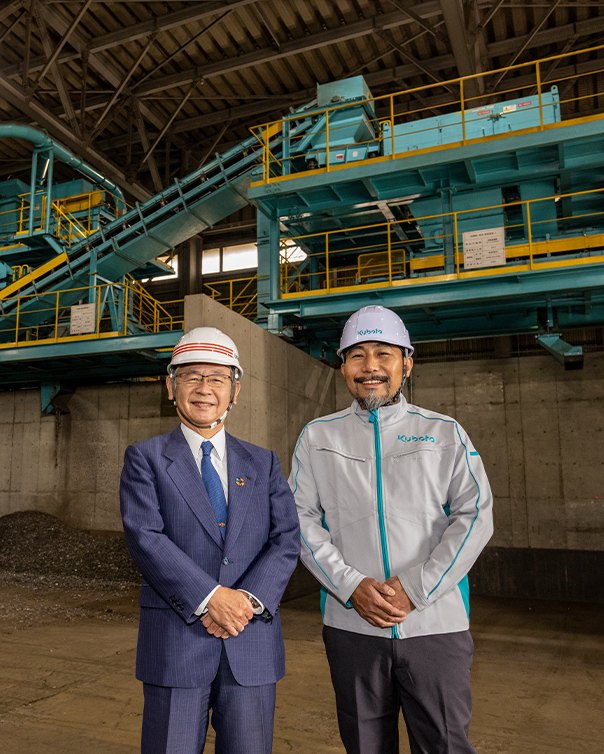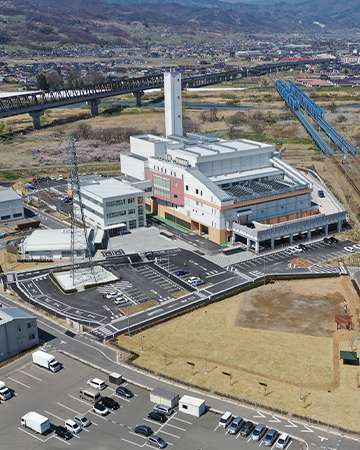
The ashes and other residues produced through the incineration of garbage and other forms of waste are melted down at high temperatures and solidified into slag. Within this slag are useful and valuable metals. For this article, we visited Kubota's Shin-yodogawa Environmental Plant Center, which is conducting demonstrations and experiments on ways to recover these metals from slag so they can be returned to society.
The Manual Work Before Machine Sorting is Like “Panning for Gold”
For the disposal of household garbage and other waste, the methods include incinerators, which burn the waste, and melting furnaces, which melt the incinerator ashes at high temperatures. Japan has a limited amount of space for landfills, so incinerators were the main method of use for many years. However, these present issues such as the approaching limit in the remaining years of use for landfills, and the environmental impact when toxic substances begin to dissolve. For these reasons, melting furnaces are attracting attention for their superior properties in reducing volume, detoxifying, and recycling waste.
Melting furnaces melt wastes at high temperatures, so they generate almost no dioxins. What is more, the slag they produce contains useful metals. They prove that so-called “urban mines” are not only found within people's mobile phones and computers. However, slag is currently used as a base material for roads, as a raw material for secondary concrete products, or as a covering material for final disposal sites. This means the treasures within do not end up seeing the light of day.
Kubota, which has been developing melting furnaces for many years, is currently conducting experiments on practical use of a device that can extract valuable metals from slag. These experiments are taking place at the Shin-yodogawa Environmental Plant Center, located near the Yodo River in Osaka. There, we were welcomed with a smile by Fumiki Hosho, the leader of the project team. We started with a tour of the processes to see how metals are extracted from slag.

The first item he showed us was a surprise: a plastic dish that is used to pan for gold in gold mines. The waste material contained within the slag naturally varies from one waste disposal site to the next, and the types and amounts of metal inside also vary, so the slag is first sorted by hand to assess its contents before machine processing begins.


“In fact, the overall metal content is about one to five percent,” says Hosho. “Slag originally has a slightly larger grain size, but the slag used here has been put through a shredder to make it finer. shredding the slag makes it easier to take out the medal contained within.”
The Separation Process with the Metal Recovery System
After hand-sorting to get a rough idea of its size, the slag is fed into a metal recovery system. It is carried from the ground to the second level on a conveyor belt, and while it is being fed into the machine from above, water flows powerfully below. This causes the heavier metal that is overcome by the water flow where it converges to fall to the bottom, and the lighter slag that floats to the top is carried away with the water and discharged to a water tank outside.

After this, we observed the moment the separated metal comes out of the lower outlet. With a flip of a switch, first heavier metals come gushing out, and then only water flows out.
“The metal is either high in iron content, which sticks to magnets, or high in copper content, which does not stick to magnets,” explains Hosho. “The metal in the melting furnace is heated at a temperature above its melting point. So if you look closely, you will see that the grains are round due to surface tension.”

The metals in the photo below look like colorful spices, but this is a side-by-side comparison of the slag from each process. The two in the center are valuable metals that stick to magnets (4) and those that do not (5).

Melting Temperatures Vary Depending on Incinerator Ash Source
Next, Hosho led us to a test building with a box-shaped electric furnace called a muffle furnace.
“Not all incinerator ashes can be melted in a 1,300℃ melting furnace,” he explained. “And even with the same sewage treatment plant, if environmental conditions cause changes in the types of waste, then the melting temperature will also change.”
For these reasons, ashes collected from each incinerator are placed in separate containers, and they are first heated in a muffle furnace to see how they melt. Various adjustments have to be made, such as giving additives to ashes that do not melt easily.


One section of this building has lots of containers, all with the same boat shape, but some looking different from the incinerator ashes (see photo below). These are the results of an experiment to determine the meltability of sewage sludge collected from sewage treatment plants in various regions. These were tested at five different temperature levels. Because it is known that sewage sludge contains useful phosphorus resources and various metals, studies are being conducted on sewage sludge as well as incinerator ashes. It also seems that sewage sludge contains different rare metals depending on which treatment plant it was taken from.

Other Tests for Using Waste Plastic as Melting Furnace Fuel
To conduct a variety of experiments in the future, the premises also features a rotating surface melting furnace. When the upper part is viewed from the outside, one can see a large cylindrical object. This is the outer casing of the double-layered furnace. As the name implies, the outer cylinder turns slowly at a speed of about one rotation per hour.
“The waste materials inserted between the outer and inner tubes are melted on the furnace's surface, which is kept at about 1,300℃,” says Hosho. “The melted clumps then drop from the hole in the center. It's a lot like the surface of raclette cheese.”

The molten slag falls into a water tank directly below the furnace, where it is quickly cooled to solidify it. Meanwhile, heavy metals that are harmful to humans, such as lead and cadmium, are gasified. These are pulled by the fan and flow to the right, and then are collected as they pass through the gas cooling tower, two-stage bag filter, and other steps. This way, only clean and harmless gas ultimately leaves the chimney. Of course, the slag is also harmless.

Kubota melting furnaces in the past have run on fuels such as kerosene, heavy oil, and gas. This facility is conducting experiments on using waste plastic as an energy source. The purpose is to develop “deep recycling technologies” that not only recover useful metals from garbage, but also create a resource cycle for all kinds of things by making fuel for waste processing from plastic that had previously been discarded.
Maximizing the Strengths of Kubota Furnaces for Separating and Concentrating Elements
So why is Kubota putting its efforts into developing a system for recovery of valuable metals using a melting system?
“Various elements are now required in order to make things that are convenient to use and beautiful to look at, such as adding lead to make colors more vivid,” explains Hosho. “This means the types of elements used have increased exponentially in the last 300 years. However, these precious metals are not being recycled properly, resulting in a single-use, one-way system of disposal. Kubota's melting furnace has an excellent system for separation and concentration of elements, so we thought we had to take advantage of this.”

According to Shigenori Inoue, who is closely involved with Hosho on this project, a metal recovery system integrated with a melting furnace has already been adopted since the time of the Teshima Waste Treatment Project. Kubota has spent more than a decade processing huge volumes of industrial waste that were illegally dumped on Teshima, an island in the Seto Inland Sea.

“The idea at Teshima was to recover a greater volume of valuable metals, even if they were mixed with slag,” says Inoue. “But in order to make effective use of rare metals, we have to improve efficiency and capacity, such as removing as much slag as possible so that only metal remains. Kubota's melting furnaces have an outstanding reputation for their capabilities in dependable processing and element concentration, and the metal recovery equipment can be retrofitted, so customers already using melting furnaces can also use it.”
“It's a shame that precious metals contained within incinerated ash are used to make cement or sent to final disposal sites and buried without being used,” adds Hosho. “Not recovering these metals means they disappear from society forever. Each day we hope that we can return these resources within the products we make to the world.”
The words from these two men express their pride in their company's products, their sense of mission to contribute to society by utilizing those benefits to the utmost, their persistent spirit of inquiry, and their lofty aspirations.





